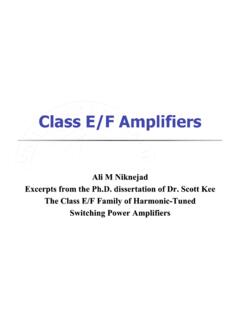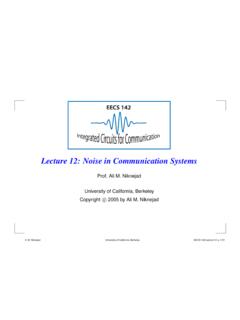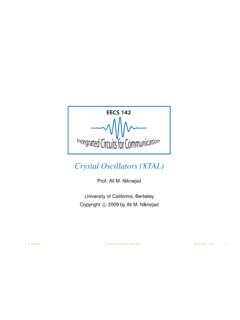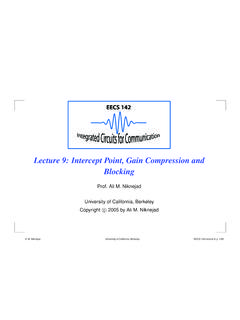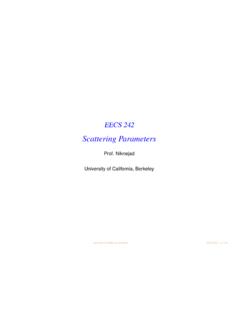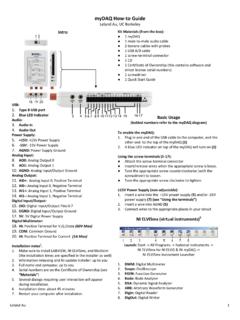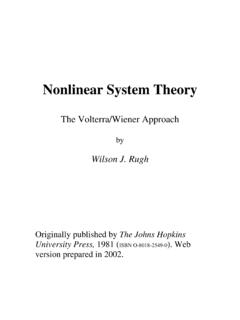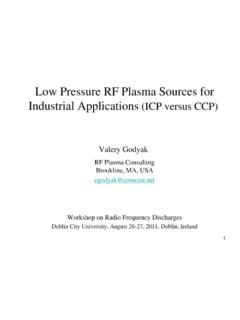Transcription of EECS 242: Mixer Noise and Design
1 eecs 242 : Mixer Noise and Design UC Berkeley eecs 242 Copyright Prof. Ali M Niknejad and Dr. Osama Shana'a Because of the image problem, a receive Mixer down converts both desired and the image bands to IF frequency. This means folding the Noise at the image frequency on top of the desired band at IF. Therefore, the total Noise at IF is as follows: 1. The Noise at desired RF band down converted to IF 2. the Noise at image RF band down converted to IF 3. The Noise added by the Mixer noisy circuit itself.
2 Ideal noiseless Mixer Ni+Gmix image Noise +Gmix IF Ni S/Ni LO image Noise IF SSB vs. DSB NF definition: UC Berkeley eecs 242 Copyright Prof. Ali M Niknejad and Dr. Osama Shana'a The single-side band NF definition assumes that there is no signal at the image frequency except the source Noise . This definition is useful in finite IF architectures, where the image signal is suppressed by an image filter before reaching the Mixer . The NF is the degradation of S/N at Mixer output.
3 Therefore, one can write: Single-side band (SSB) NF UC Berkeley eecs 242 Copyright Prof. Ali M Niknejad and Dr. Osama Shana'a As seen from the SSB Noise figure equation, if the Mixer is noiseless (Nmix=0), the Mixer SSB NF is 3dB because of the image Noise folding. It is important to know that this definition is the one used by microwave Mixer designers for years. It is also the definition used in SpectreRF simulator. The IEEE definition of Single-Side band (SSB) NF: The IEEE has a slightly different definition for SSB NF.
4 It argues that the Mixer should not be penalized by the image source Noise folding. The only image Noise folding that is allowed to count towards calculating the Mixer SSB NF is that which is due to the Mixer circuitry itself. The input image Noise should not be counted. Therefore, the IEEE SSB NF assumes there is a sharp bandpass filter that passes the desired band with the source Noise and knocks down the image Noise to the negligible level. As a result, one can write IEEE Noise Definition UC Berkeley eecs 242 Copyright Prof.
5 Ali M Niknejad and Dr. Osama Shana'a IEEE Noise Def (cont) Nd Sd/Nd LO image Noise IF Nd+Gmix IF Noiseless Mixer Image Noise filter As seen from the IEEE SSB equation, if the Mixer is noiseless, the Mixer SSB NF is actually 0dB, the spirit behind the new definition. UC Berkeley eecs 242 Copyright Prof. Ali M Niknejad and Dr. Osama Shana'a Nd+Gmix_d IF Noiseless Mixer Nd Sd/Nd LO image Noise IF The double-side band NF definition assumes that the image band contains both Noise and an image signal identical to the desired band signal.
6 This definition is useful in direct-conversion receiver where the image is the signal itself. Therefore, one can write: image Nim+Gmix_im Double-Side band (DSB) NF: UC Berkeley eecs 242 Copyright Prof. Ali M Niknejad and Dr. Osama Shana'a Therefore: DSB NF (cont) It can be seen that the difference between the SSB NF and DSB NF is exactly 3dB. However, with the SSB_IEEE, the difference is not exactly 3dB. In fact the difference between the SSB_IEEE and the SSB NF approaches 3dB as the Mixer NF is very high.
7 The SSB_IEEE Noise factor can be related to that of the DSB as: UC Berkeley eecs 242 Copyright Prof. Ali M Niknejad and Dr. Osama Shana'a Periodically Time-Varying Systems UC Berkeley eecs 242 Copyright Prof. Ali M Niknejad and Dr. Osama Shana'a Suppose the AC signal at output is given by Let X(f) be the spectrum of is Y(f) be the spectrum of Io1 If we fix the output frequency at fIF, then we see energy from multiple bands folding into output spectrum 0 IF LO-IF LO+IF 2LO-IF 2LO+IF LO 2LO Mixer Conversion Gain UC Berkeley eecs 242 Copyright Prof.
8 Ali M Niknejad and Dr. Osama Shana'a n=+1 fLO-fIF n=-1 fLO+fIF n=+2 2fLO-fIF The coefficient P1, k then represents the conversion gain from frequency k fLO fIF to fIF. If we assume hard switching, then P1(t) is a square wave and the coefficients are Single and Double Bal Mixer UC Berkeley eecs 242 Copyright Prof. Ali M Niknejad and Dr. Osama Shana'a M1M2M3I1I2 VLOIo1= I1-I2 Vin+-I3= IB+isM1M2M3M5M4M6 VLOIo2Io1I1I2I4I5I3 = IB+isI6= IB-is2 IBVin+-Io = Io1-Io2 = (I1-I2)-(I5-I4)Core Noise Model UC Berkeley eecs 242 Copyright Prof.
9 Ali M Niknejad and Dr. Osama Shana'a M1M2M3I1I2 VLOIo1= I1-I2 Vin+-I3= IB+isM1M2I1I2 VLOIo1= I1-I2+-I3= IB+is(a)(b)VLO(t)tVx-Vxttp0(t)p1(t)IB-IB 1-1!VoTLON oise from Gm Stage UC Berkeley eecs 242 Copyright Prof. Ali M Niknejad and Dr. Osama Shana'a WSS PSD A cyclostationary process is a random process whose statistics are periodic functions of time The PSD of a cyclostationary process is given by S(f,t) If we measure a cyclostationary process over a bandwidth < 1/period, we observe , a stationary process Example: White Noise deter periodic func.
10 Gm Stage Noise (cont) UC Berkeley eecs 242 Copyright Prof. Ali M Niknejad and Dr. Osama Shana'a If Sn3(t)=Nn3 (white), then For a square wave p1(t), +1 -1 For first sidebands (fLO fIF), this Noise accounts for of Noise . Gm Stage Noise (cont) UC Berkeley eecs 242 Copyright Prof. Ali M Niknejad and Dr. Osama Shana'a accounts for The remaining harmonics account for the rest ~ 10% vo vx -vx -vo +1 Assume p1(t) is a straight line during period when both devices on Single Balanced Mixer Noise UC Berkeley eecs 242 Copyright Prof.

